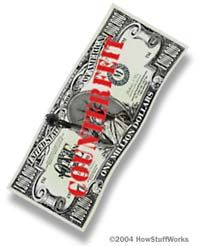Yes. Lots of people know what money "feels" like. People who handle money constantly, like bank tellers, cashiers and waitstaff, can feel a counterfeit bill instantly if the paper is wrong.
That "feel of money" comes from at least three different things that make the paper in paper bills unique:
Advertisement
- Normal paper that you use on a day-to-day basis (newspaper, notebook paper, paper in books, etc.) is made from the cellulose found in trees. Paper used for money, on the other hand, is made from cotton and linen fibers. This kind of paper is known as rag paper. One big advantage of using rag paper is the fact that it does not disintegrate if you accidentally run paper money through a washing machine.
- The paper used for money is thin compared to normal paper.
- The paper used for money is squeezed with thousands of pounds of pressure during the printing process. This makes it even thinner and gives newly-made bills a special crispness.
The other special thing about the rag paper used in real money is that there are tiny blue and red fibers mixed into the paper when it is made. These fibers are easy to find in real money, but they are so fine that they do not reproduce very well in counterfeit money that is made on a printer.
The last thing a counterfeiter wants to do is print counterfeit money on "normal" printer paper. It will feel all wrong, and it can be detected with a counterfeit pen. These special pens, which often look something like a highlighter, contain iodine that changes color when it comes in contact with cellulose.
Here are some interesting links:
- How Counterfeiting Works
- How does a counterfeit detector pen work?
- How Currency Works
- How Banks Work
- How ATMs Work
- How The Fed Works
- The United States Secret Service Counterfeit Division
- United States Department of the Treasury
- Counterfeiting Money
- 12-year-old nabbed for printing $1 bills
- Woman says she thought $1 million bill was real
Advertisement
